It’s no surprise that people feel overwhelmed by climate change. The bushfires of last summer were a brutal reminder of how utterly powerless we can be in the face of mother nature.
You may have also heard that Australia is one of the highest per-capita emitters of greenhouse gases in the world.
There is a lot of talk about the problem of climate change and who’s to blame. But not so much about the actual causes and specific solutions to climate change. In this article, I will attempt to, as briefly as possible, outline just that:
- Where our greenhouse gas emissions come from in Australia, and
- What you can do to help reduce them, and begin to halt climate change.
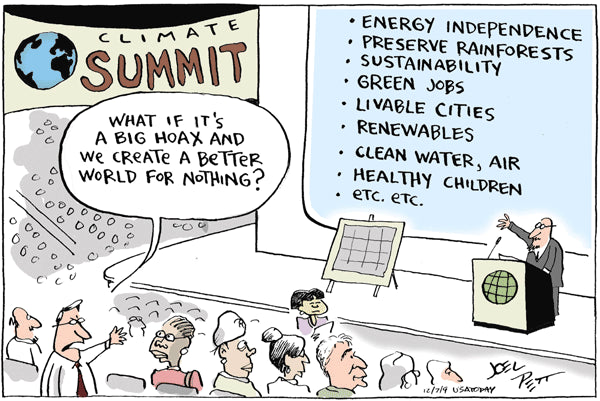
Climate change cartoon by Joel Pett, USA Today, 2009.
But before we begin, a quick recap on what is meant by 'climate change'.
The Greenhouse Effect & Climate Change
Despite what scientists and the media may have you thinking, climate change isn’t all that complex. The greenhouse effect is completely natural and necessary. It's what keeps planet Earth at a habitable temperature. Even water vapour is a greenhouse gas.
It’s our recent injection of additional greenhouse gases into the atmosphere that is causing some problems. This includes things like carbon dioxide from burning fossil fuels, methane from leaking coal seam gas mines, and the refrigerant gases used in air conditioning systems. That’s why the boffins call it anthropogenic climate change - a fancy way of saying it’s human-induced, not naturally occurring.
These extra greenhouse gases are what cause more heating up of our atmosphere. The sunlight still comes in just like it always has, but less of it can radiate back out to space as heat. A smidgen more of this infrared radiation is trapped by the extra greenhouse gas molecules in our atmosphere. This is the most important factor in what causes climate change.

A simple summary of how the greenhouse gas effect works.
Stick with me, this guide gets more practical in just a sec.
Where Australia’s Emissions Come From
Put simply, to reduce climate change risks we need to drastically cut greenhouse gas emissions. And to do that, we need to understand where these emissions are coming from.
In Australia, our greenhouse gas emissions come from the following areas, in order of their current impact:
- Electricity
- Direct Combustion
- Transportation
- Agriculture
- Fugitive Emissions
- Industrial Processes
- Waste
- Land Use Change
Interestingly, over three-quarters of our excess greenhouse gas emissions come from our prodigious use of energy. Electricity, transportation, direct combustion, and fugitive emissions are all energy-related issues.
Australia’s energy consumption is something that we can alter almost overnight at home, and in a short space of time at work. The government-led solutions that many people are yearning for are often the least effective, most costly, and slowest to implement.
Now, let's break that down in a bit more detail - including what you can do about it.
Electricity Generation & Climate Change

In Australia, electricity is responsible for about 34% of our climate-changing greenhouse gases. This is largely due to our high dependence on coal to generate electricity. Even though we are also the world leader in per-capita solar panel installations (link), there is a lot more to be done.
There are two main things you can do to reduce the consequences of your electricity usage on climate change.
Solution 1) Double Down on Energy Efficiency
In my opinion, energy efficiency is our most important tool to combat climate change. With respect to electricity consumption, here's what you can do:
Firstly, you need to understand where electricity is being used. Install an electricity usage monitor or review my blog on the top ten causes of high electricity bills. Don't forget to do this at work and at home. Your workplace is likely to use a lot more power than your household. The same can be said for your local club, church, or other community group.
Generally speaking the biggest energy users in most buildings are:
- Heating & Cooling
- Lighting
- Hot Water
- Appliances & Equipment
The above links go straight to some of the products we sell to drastically cut electricity consumption in these key areas.
For a much more details breakdown, I suggest you read my blog post on the top ten cause of high energy bills. Even if you do not regard your electricity or gas bills as being "high" the issues discussed are very likely to make up the majority of your usage.
Solution 2) Install or Facilitate More Solar Power
Solar power is now so cheap that it is economically irrational not install it. Solar power is cheaper than grid power for almost all electricity consumers in Australia.
The maths is quite simple. For most households and businesses, solar panels will pay for themselves in less than 4 years but are warrantied for over 20 years.
No one that I know has regretted installing too much solar power. But many people regret not having installed more. In summary, go large. If you follow my tips under 'direct combustion' and 'transportation' sections below we are going to need even more solar power generation in the future. You can use a website like Solar Quotes to learn much more about solar power and gather three quotes for your property.
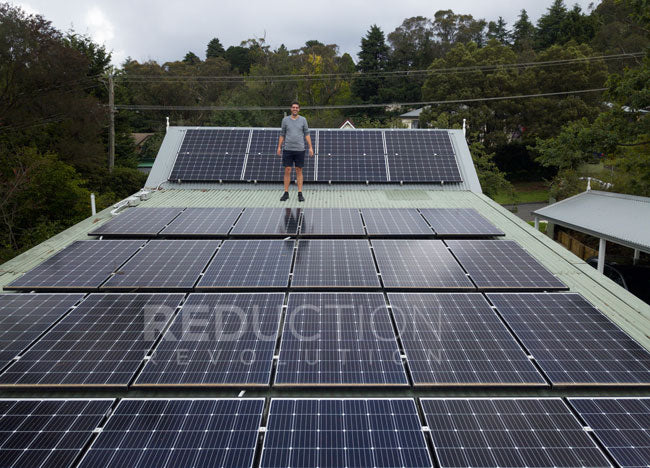
I recently replaced a six-panel solar system on my roof (over 10 years old from the previous owner) with 32 panels (10kW).
If you rent, ask your landlord to install solar power. You could even get the quotes for them, and offer to pay half the installation cost via a small rental increase (for example). You'll reap the benefits in the form of reduced electricity bills.
If you live in an apartment building, help your strata committee obtain some quotes. Depending on the size of your building (and accessibility/wiring) you can either divvy the roof up for each unit, or (at least) power the common property with solar power.
Get your workplace to do the same. In fact, you should sort your workplace out first. Most businesses are an even better match for solar than households. This is due to the fact that most businesses operate at their peak electricity demand during the day - right when solar panels are making the most power.
Direct Combustion & Climate Change

Next up we have Direct Combustion at 19% of Australia's emissions. This includes emissions from burning fossil fuels, usually for heat or steam. Examples include metals manufacturing, fuel use by LNG (Liquefied Natural Gas) processing, and the gas used by domestic heating, cooking, and hot water systems.
Solution 3) Quit The Gas Grid
Australia exports a monumental amount of coal and gas to other countries. This is a true statement, but a poor argument for shirking our own responsibility. You may be a small part of a big problem, but I am reminded here of a quote:
"Never doubt that a small group of thoughtful, committed citizens can change the world; indeed, it's the only thing that ever has." - Margaret Mead
Which brings me back to my point: you should quit the gas grid. And this is how you can do it:
- Replace gas hot water systems with heat pump hot water (or instant electric).
- Replace gas heaters and gas boilers with high-efficiency air conditioners (preferably high star rated split systems).
- Replace gas stoves with induction.
Once you've done that, you can call up your gas retailer and close your gas account for good. This can be a little more tricky to implement if you are renting. However, in many properties, it is only the stovetop which uses gas. If this is the case for you, you can buy a portable induction cooker, and still quit the gas grid.
Quitting the gas grid or going "all-electric" does not only save you money on gas. It also eliminates the daily service fee that you pay, which is often the most expensive part of the bill.
I am referring here to mains gas, but the exact same theory applies to LPG bottled gas. It too is a fossil fuel.
Transportation's Impact on Climate Change in Australia
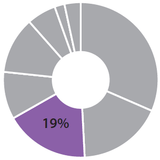
Then we have Transportation which also comes in at 19% of total Australia's emissions. No surprises here, as just about all of our vehicles still burn fossil fuels to operate. Cars are the biggest culprits with trucks a close second. In reality, this percentage should be higher. For accounting reasons, it only includes domestic aviation. But make no mistake: when you fly international, you cause those emissions!
Solution 4) Travel Less & Live More
Hands up who wants a longer commute and more jetlag?
Time spent 'in transit' is generally dead time and it's not enjoyable. If we do less of it, not only will we reduce carbon emissions, but we also get to spend more time doing other more valuable activities. Here are two important examples:
Commuting. No one likes a long commute (whether in a car, train, or a bus). The best solution we have here is remote working. This could mean working from home a few days a week. Or it could mean working closer to home (eg. at a shared office) somewhere you can walk or ride your bike to.
Air Travel. Let's get one thing clear: flying is not glamorous. The airlines spend a lot of time making you think it is, or that you are important if you fly often. It's not, and you aren't. Whether you travel a lot for work or pleasure, aim for more deliberate travel. Why not accrue your leave and take a few months off for overseas travel? Or travel locally and drive there in your new hybrid (see next point)?
Note: air travel gets a bad rap and for good reason. But the main problem with fossil-fueled travel is distance. Travelling by air is not actually that much worse than driving (ie. emissions per kilometre). The issue is that flying allows us to cover vast distances very quickly.
Solution 5) Electrify Your Transportation
Electric vehicles, much like solar power, have now become an inevitable no-brainer. What we need to do, with respect to climate change, is hasten our transition to them.
Your first step should be to eliminate or reduce the need to travel in the first place. Once you have done so you may find that using a car share service when needed, or an electric bicycle is more than sufficient for local travel.
Anyway, here's why I say electric vehicles are a no brainer. The equivalent cost of running a car on electricity is about 40 cents per litre. If you charge your car during the day from the solar panels you installed earlier this drops to just 20 cents per litre (equivalent).
If you are in the market for a vehicle and there is no affordable electric vehicle (EV) or plug-in hybrid's (PHEV) then I would wait a year or two until there is. Also, be sure to check the used car market or you can even import one from Japan (seriously).
How Australian Agriculture Contributes to Climate Change
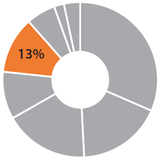
Emissions from Agriculture have a similar impact at 13% of Australia total. This section could just as well be called Livestock because about 90% of agriculture's emissions are from cattle, dairy, sheep and pigs. The balance being from all crops, fertilisers, and other farmed animals.
Solution 6) Eat Less Meat & Dairy
If you don't want to do it for the environment, or for animal welfare, you can at least do it for your health. Some of the leading causes of death and disease are now known to have a significant causal relationship with what you eat. And things are not looking good for meat and dairy.
I'm no expert on diet or agriculture - which is why I have spent most of my time talking about energy. But I'm sure you'll come to the same conclusion as I have: consuming less animal-derived products has far more upsides than downsides.
Climate Change Causes - Fugitive Emissions

So-called fugitives are responsible for a further 11% of emissions. As the name suggests, these are the emissions which escaped when they shouldn't have. Like leaks from coal seam gas mines, oil and gas processing plants, and leaking domestic gas pipes. In case you needed another reason to quit the gas grid and fossil fuels, here it is!
Climate Change Causes - Industrial Processes
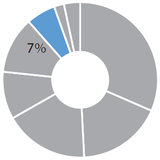
Industrial Processes are next, coming in at 7% of Australia's emissions. This is where greenhouse gases are emitted as an uncontained byproduct of another process. Examples include the synthetic 'HFC' refrigerant gases in air conditioning systems, emissions from mineral production, and even emissions from food and beverage manufacturing.
The Impact of Waste on Climate Change

Finally, we have the Waste sector at 2%. These emissions are mostly from landfills, sewerage, and other wastewater treatment. Waste to landfill is almost in three equal parts from municipal waste (domestic), commercial waste, and the waste from the construction and demolition. These are all areas we contribute to, in one way or another.
Uh oh, how did we get to 105%!? Don't worry, it's not a rounding error, although that does end up being 1%.
How Land Use Change Affects The Climate

Land Use, Land-Use Change and Forestry (LULUCF) brings us back into line with minus 4%. This sector is the home of the infamous 'accounting trick' used by our nation's Kyoto climate change agreement negotiators (details here). Even so, it is a real and important thing and includes sequestered emissions from increased forest coverage and more carbon in soils. In other words: better land management.
As I mentioned at the start, climate change can seem like a daunting topic. But it's liberating to think that we already know what causes it. And it's empowering to know that you can take meaningful action to help address it, right now.
Here are the six high-impact actions that I have outlined in this article:
- Double down on energy efficiency
- Install or facilitate more solar power
- Quit the gas grid
- Travel less & live more
- Electrify your transportation
- Eat less meat & dairy
So go on - why not get started with 'solution 1' and double down on energy efficiency. Monitor your energy usage, upgrade your lighting and get smarter with your appliance choices.
All percentages quoted in this article are derived from the report "Quarterly Update of Australia’s National Greenhouse Gas Inventory: June 2019".








